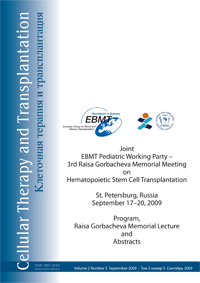Developing new immunological compatible transplants derived from umbilical cord
Artur A. Isaev1, Alexander V. Prihodko1, Irina N. Saburina2, Sergey L. Kiselev1, Varvara S. Melihova2, Ivan V. Potapov1, Alexey V. Lundup1
1Human Stem Cells Institute, Moscow, Russia; 2Laboratory of Cell Technology, Moscow, Russia
Summary
Rejection, immunosuppression, and tissue and organ compatibility selection are crucial problems in current transplantology. One promising approach is autologous cell transplantation. Therefore investigators and clinicians at present time focus their attention on autologous cell and tissue banking and their storage.
The umbilical cord is the structure containing mesenchymal cells, e.g. fibroblast-like cells (FLC) and umbilical vein endothelial cells (HUVEC). FLC are known as a source for skin burns and scars treatment, while HUVEC can be used for ischemic tissues revascularization. Therefore, developing new isolation protocols, cell culture expansion, and cell banking methods from the umbilical cord are important issues for immunologically compatible transplants in contemporary clinical use.
Here we present our method of consecutive isolation, cultivation, and cryopreservation of two cell types – HUVEC and FLC – from one umbilical cord sample. Plastic-adherent cell cultures that contained diploid cells with high proliferative activity were observed for 4–6 passages. FLC expressed vimentin, collagen types 1 and 4, alfa-actin, possessed low MHC expression, and did not express CD45, CD11b, or CD14. Cultivated HUVEC demonstrated endotheliocyte-like phenotype, expressed the Von Willebrand factor, and formed tubular structures. Both FLC and HUVEC were cryopreserved for a long period and thawed without a lack of morphofunctional properties.
Thus, the proposed method of consecutive isolation provides the possibility to isolate and preserve two cell types from one umbilical cord sample without changing traditional cord blood banking protocols. These cells can be used for autotransplantation in the treatment of numerous diseases and expand the role of personal cell banking as a “biological insurance.”
Keywords
umbilical cord, fibroblast-like cells, HUVEC, banking


